
Rubus spectabilis, the salmonberry, is a species of brambles in the rose family, native to the west coast of North America from west central Alaska to California, inland as far as Idaho.

Platanus racemosa is a species of plane tree known by several common names, including California sycamore, western sycamore, California plane tree, and in North American Spanish aliso. Platanus racemosa is native to California and Baja California, where it grows in riparian areas, canyons, floodplains, at springs and seeps, and along streams and rivers in several types of habitats. It has been found as far north as Tehama and Humboldt counties.
Hawaiian hibiscus are seven species of hibiscus native to Hawaii. The yellow hibiscus is Hawaii's state flower. Most commonly grown as ornamental plants in the Hawaiian Islands are the Chinese hibiscus and its numerous hybrids, though the native Hibiscus arnottianus is occasionally planted.

Avicennia germinans, the black mangrove, is a shrub or small tree to 12 meters (39') in the acanthus family, Acanthaceae. It grows in tropical and subtropical regions of the Americas, on both the Atlantic and Pacific Coasts, and on the Atlantic Coast of tropical Africa, where it thrives on the sandy and muddy shores where seawater reaches. It is common throughout coastal areas of Texas and Florida, and ranges as far north as southern Louisiana and coastal Georgia in the United States.

Ficus racemosa, the cluster fig, red river fig or gular, is a species of plant in the family Moraceae. It is native to Australia and tropical Asia. It is a fast-growing plant with large, very rough leaves, usually attaining the size of a large shrub, although older specimens can grow quite large and gnarled. It is unusual in that its figs grow on or close to the tree trunk, termed cauliflory.

Acacia complanata, known as long-pod wattle and flat-stemmed wattle, is a perennial tree native to eastern Australia.

Arbutus xalapensis, commonly known as the Texas madrone, naked Indian tree or Texas madroño, is a species of flowering plant in the heather family. It is native to Central America, the southwestern United States, and throughout Mexico. It is found in canyons and mountains, on rocky plains, and in oak woodlands, at altitudes of up to 3,000 m in the south of the range, but lower, down to 600 m in the north of the range.
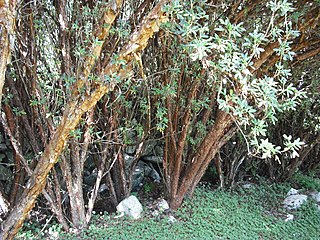
Polylepis racemosa is a species of small tree in the family Rosaceae. It is endemic to Peru, Bolivia, and Ecuador. It is threatened by habitat destruction. The International Union for Conservation of Nature has assessed the conservation status of this tree as "vulnerable".

Illicium floridanum is an evergreen shrub native to the southeastern United States, especially Florida and Louisiana.

Sambucus racemosa is a species of elderberry known by the common names red elderberry and red-berried elder.

The Cuban dry forests are a tropical dry forest ecoregion that occupies 65,800 km2 (25,400 sq mi) on Cuba and Isla de la Juventud. The ecoregion receives 1,000–2,000 mm (39–79 in) of rainfall annually. Cuban dry forests can be differentiated into evergreen forests, semi-deciduous forests, mogotes, and sclerophyllous low forests.
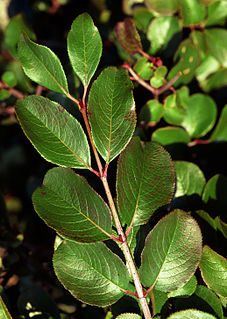
Viburnum rufidulum, also known as the rusty blackhaw, blue haw, rusty nanny-berry, or southern black haw, is a flowering species of shrub or small tree that is common in parts of the Eastern and Central United States. It produces attractive flowers and fall foliage, as well as fruits that are popular with some species of bird.

Aesculus sylvatica, the painted buckeye, is a species of shrub. The species has five leaflets that are 4.5 to 6 inches long and 1.5 to 2.5 inches wide. The flowers are yellow and occasionally have red also. The species have dry fruit and brown, scaly bark. The species is commonly found in forests and along stream banks. The shrub is poisonous, as are its seeds.
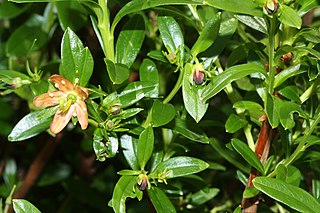
Elliottia is a genus of plants in the Ericaceae, with four species, two in North American and two in Japan. It is named after botanist Stephen Elliott.

Exochorda racemosa, pearlbush or common pearlbush, is a species of plant in the rose family. This species is mostly found in China and Japan.

Hakea leucoptera, commonly known as silver needlewood, needle hakea, pin bush or water tree and as booldoobah in Koori language, is a shrub or small tree with rigid, cylindrical, sharply pointed leaves and white, cream-coloured or yellow flowers in late spring and early summer. It is widespread and common in central parts of the Australian mainland.

Myrica inodora is a plant species native to the coastal plains on the northern shore of the Gulf of Mexico, in the Florida Panhandle, the extreme southern parts of Alabama and Mississippi, eastern Louisiana and southwestern Georgia. Common names include scentless bayberry, odorless bayberry, odorless wax-myrtle, waxberry, candleberry, and waxtree. It grows in swamps, bogs, pond edges and stream banks.
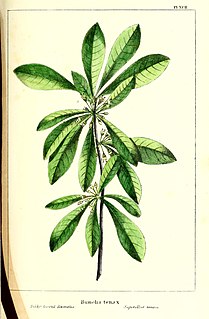
Sideroxylon tenax, called the tough bully, is a plant species native to Florida, Georgia, South Carolina and the southernmost part of North Carolina. It grows on dry, sandy soil in pine forests, pine-oak woodlands, and hummocks at elevations less than 100 m.

Protea grandiceps, commonly known as rooisuikerbos, suikerbos or red sugarbush, is a flowering shrub that belongs to the Protea genus and is native to parts south western parts of South Africa. The shrub was listed as an+ near threatened species in 2006 according to the South African National Biodiversity Institute.
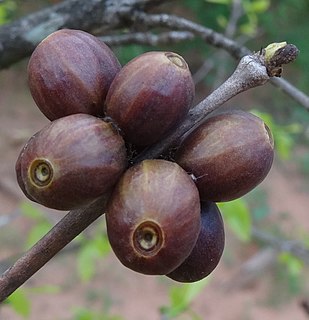
Coffea racemosa, or racemosa coffee, is a species of flowering plant in the family Rubiaceae. It has naturally low levels of caffeine, less than half of that found in Coffea arabica, and a quarter of that in Robusta coffee. It is endemic to the coastal forest belt between northern KwaZulu-Natal in South Africa and Zimbabwe, found in an area less than 150 km2 (58 sq mi) in size. It was widely cultivated by the Portuguese during the 1960-1970s in Mozambique, currently there are only two plantations at Ibo Island and in Hluhluwe, which remain.





















